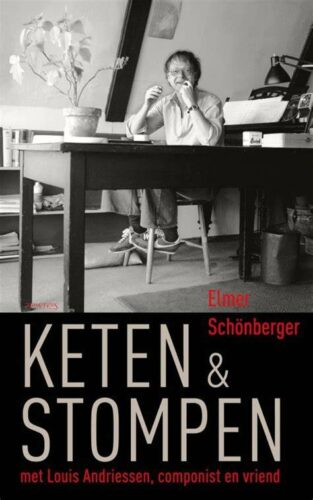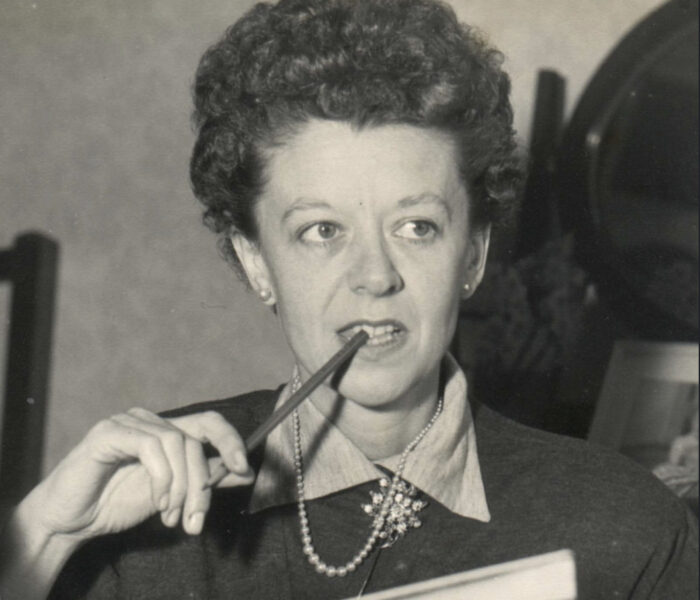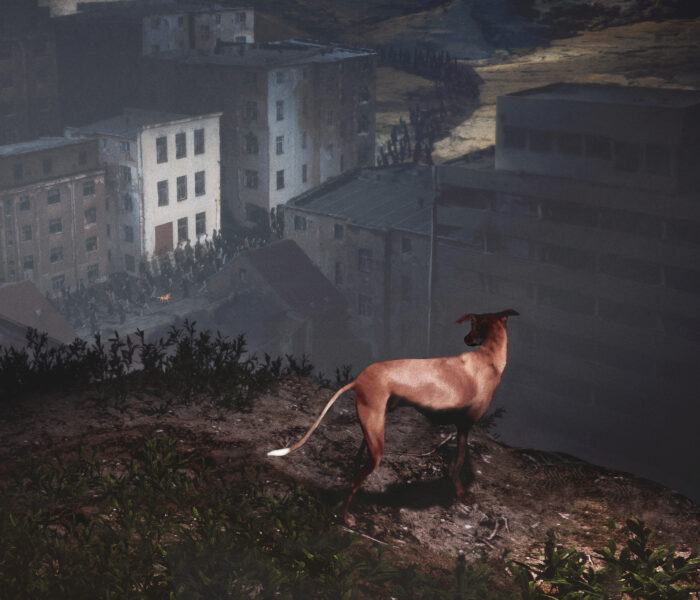During his lifetime, the Dutch composer Louis Andriessen (1939-2021) continuously challenged musical and social boundaries. His radical and thoroughly engaging music has reonated with afficionados all over the world. Composer and writer Elmer Schönberger was his favorite music critic and close friend. Together, they wrote the ground-breaking book: The Apollonian Clockwork. On Stravinsky (1). After Andriessen's death in 2021, Schönberger went down memory lane and wrote a jewel of a book about the close friendship between Louis A. and Elmer S., spanning more than forty years from the 1970s onwards, with the (quite untranslatable) title Keten en stompen (2).
On this occasion, Mirjam Zegers, Andriessen's long-standing personal assistant, spoke with Elmer Schönberger.
Elmer, in March 2023, you published a book about composer Louis Andriessen and your close friendship which began some 45 years ago. The Dutch title is, Keten en stompenwhich immediately paints a touching picture of him and your friendship. Can you say a little more about that?
Louis was above all a playful spirit, prototype of Johan Huizinga's homo ludens. A doer but one who thought a lot and was constantly aware of the game he was playing as a man and as a composer. For without seriousness there is no game. And then again, he came from a large, cheerful Catholic family, thoroughly artistic, specifically musical, headed by a widely respected composer, Hendrik Andriessen, who loved to write limericks when he wasn't working on a new Mass or improvising on the organ.
"Keten", one of Louis' favorite words, is hard to translate. It means something like "revel", being together in a pleasant way. It is also a form of play and much more than merely "having fun". "Keten", was celebrating life - joking, playing cards, eating, drinking, going out, flirting and all of the attendant forms of ebullient social interaction. In my friendship with Louis, "keten" often preceded "stomping", playing Bach and Stravinsky together on the two grand pianos in the attic of his house on Amsterdam's Keizersgracht.
"Stompen" is the Dutchified version of "stomp", as inAlbert Ammons' Boogie Woogie Stomp, and with that word Louis affectionately referred to his early youth when he and his cousin Wim Witteman formed a frenzied boogiewoogie duo.
Boogie-woogie is also in the roots of his work, like early Miles Davis and Charlie Parker. Louis first encountered them in the 1950s, thanks to his elder brother Jurriaan, who had spent a few years in the United States and returned with a remarkable "au courant" record collection. Louis also enjoyed listening to an American radio station that was active in Europe at that time. How can you characterize the significance of boogie-woogie and cool jazz to Louis' work?
As a composer, as an artist, you can roughly do two things: you either nurture your roots or you cut them off. Louis is a prime example of the first option. Hence the stylistic versatility of his music, its inclusiveness. Both jazz and Stravinsky, Bach and Poulenc, father Hendrik and brother Jurriaan, later also Cage, Reich, Vivier, Stockhausen and so on: this is what pre-eminently characterizes the embracing composer. But that embrace is not uncritical. Hence Louis' beloved expression that his music is always "being about" something. For example "about" boogie-woogie, as in On Jimmy Yancey and De Stijl (Le Style), or "about" Charlie Parker's bebop in Facing Death . "Being about" implies a certain distance, an inquisitive look at an existing genre, at a particular style, composer or musical form. On a deeper, more fundamental level, jazz has had an underlying impact on Andriessen as a whole. The attaque, the block chords, the tutti character of the brass-dominated sound of De Staat (La République, 1972) - and of the many pieces in which De Staat resonates: all that is inconceivable without the American big bands of Stan Kenton and Miles Davis. And Louis does this without ever literally referring to them. You could consider it a higher form of "being about".
You mention De Staat(The Republic), in which Andriessen considers the relationship between music and politics. In his 1976 program note to the piece, Andriessen describes what concerned him:
I've decided to draw upon Plato to illustrate what I mean. Everyone sees the absurdity of Plato's statement that the Mixolydian mode (3) should be banned because of its damaging effect on the development of character. It is equally clear that he was confusing the issue of wanting to ban dulcimers (4) and the craftsmen who made them from his ideal state. What he wished to ban was the social effect of music played on them, something similar perhaps to the "demoralizing nature" of the Rolling Stones concerts.
My second reason for writing De Staat is in direct contradiction to the first. Perhaps I regret the fact that Plato was wrong: if only it were true that musical innovation represented a danger to the state! When Bertolt Brecht returned to Europe after the war, he chose to settle in East Germany. The first play he wrote there was censored by the party. But Brecht said to the assembled Western journalists : "In what Western country would the government take the time and trouble to spend thirty hours discussing my plays with me?"
In your book Keten en stompen, you write: "With a bit of exaggeration, one could see De Staat as the moment the Real Louis Andriessen emerged". What exactly makes you think so?
Say "Louis Andriessen" and a mixture of musical character traits and associations pops up, similar to the way it happens when you say "Pierre Boulez", "Steve Reich" or, why not, "Michel Legrand". What we call "typical Reich" - but the same goes for Beethoven or Stravinsky, exists only in our heads. It is a halo of variables that, quite paradoxically, together form a constant. In other words, a collection of properties that consists of many, partially overlapping, subsets; virtually each work has its own subset. When I call De Staat the emergence of the Real Louis Andriessen, by this I mean that there is a kind of chemical reaction taking place in that piece that represents a fundamental transformation in Andriessen's development - a kind of pupation. The melodic, harmonic, rhythmic and dynamic building blocks of the score - minimal American and earthy Dutch - can all be be traceable to earlier work, both by Andriessen himself as well as by fellow composers, it is that je ne sais quoi that makes everything rise above itself as never before. Take just the deployment of the first "tutti", three minutes after the beginning. This is and remains pure magic, not a second too early, not a second too late. And timing is just one of the many distinguishing characteristics that make De Staat unique.
Finally, Plato or no Plato, Brecht or no Brecht, even for those without any prior knowledge of the background and De Staat's sources of inspiration, it remains unsettling music, a form of compositional polemic that one understands even without knowing its stakes.


Louis spent his entire life looking for new ways to break down musical boundaries, to dissolve the divisions between so-called high and low culture, and to overthrow existing hierarchies. The voice has his special attention. Could you highlight that aspect for the De Staatperiod ?
Breaking down boundaries is also about your own boundaries - in Louis' case, for example, between two sharply distinguished ways of vocal writing. Take De Staat, on the one hand, and La Passion selon Matthieu, the "opera" he composed for the theatrical group Baal, on the other. I deliberately mention two pieces composed immediately after each other. The Matthew Passion was made for actors. In other words, the voices we hear belong to characters, to human beings, and so they sing, with the corresponding limitations due to unskilled resources. De Staat underlies the subgenre of Louis' work in which the voice is above all a mouthpiece - giving expression to an idea and subordinating itself musically to the bigger picture. In other words, in pieces such as De Staat, De Tijd (Time) but also Tao and, to some extent, De Materie (Matter), text and voice are fully embedded in the often complex instrumental structure. De Staat is not a piece for four vocal soloists and large ensemble but for large ensemble including four voices. In later works, Louis brought these two vocal practices towards each other more and more, just as he also increasingly united the conceptual of his autonomous music with the freedom of his functional work. This has enriched his music. Anyway, whether it was demonstrative prose or testimonial poetry, words were important to Louis. Just as his childhood friend Peter Vos, the genial, literary anchored illustrator, sometimes spoke of "writing down drawings", Louis could have talk about "telling music".
You referred to the combination of "stylized modernism and low-key functionalism", as what inspired most in his music. Andriessen was often called "eclectic", but he himself hated that word. What exactly fascinates you in that combination of "high" and "low" and can you elaborate on the meaning of that word "eclectic" in Andriessen's universe?
Eclectic was for Louis's generation - and mind as well - a swear word, one that stood for characterless and self-indulgent shopping. No one, apart from a single Adornian sharpshooter, calls Stravinsky eclectic (literally: selective), but he was. Be it that he critically and creatively selected techniques and subsequently used them wholly to his own liking. That is the Stravinsky from whom Louis took an example, and that is what saved him from the modernist trap of trying to shape any idea into one and the same densely scripted musical language. In doing so he could rely on the immutability of his writing. What fascinates me personally is not so much the bringing together of "high" and "low" but of the disparate musical worlds that now simply play a role in our listening experience. I like to hear, or at least suspect to hear, the whole person in a composer's music. In the case of Louis, that is someone who, to name a few examples, loves Bach and Vivier, Ravel and Cage, father Hendrik Andriessen and gagaku, Stockhausen and Les Double Six, brother Jurriaan and Morricone.
Interview by Mirjam Zegers*.
With the support of Performing Arts Fund (NL)
Thanks to Monica Andriessen-Germino
*Mirjam Zegers has published texts and interviews in The Art of Stealing Time (Todmorden, Art Publications, 2002). Together with Andriessen's heirs and other friends, she is looking after his legacy as curator of the Louis Andriessen Platform (currently under construction).
(1) The original Dutch version of Het apollinisch uurwerk was published in 1983 by De Bezige Bij, Amsterdam. The English translation was published in 1990 by Oxford University Press and is still available in a 2006 reprint by Amsterdam University Press.
(2) Elmer Schönberger, Keten en stompenAmsterdam, Uitgeverij Prometheus, 2023.
(3) The Mixolydian mode is an ancient Greek mode.
(4) Stringed instrument.
Photo © Ilja Keizer



)



